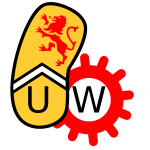Team:Waterloo
From 2008.igem.org
| Line 12: | Line 12: | ||
<table border="0"> | <table border="0"> | ||
| - | + | <tr> | |
| - | + | <td align="center">[[Image:UWiGEMLogo.png|200px|right]]</td> | |
| - | + | <td align="left"> The University of Waterloo 2008 iGEM Team is an interdisciplinary, undergraduate-run group spanning the Faculties of Science, Mathematics, and Engineering. Our undergraduate members and graduate and faculty advisors bring skills, expertise, and perspectives from a broad range of fields, including Biology, Biochemistry, Computer Science, Bioinformatics, Computer and Electrical Engineering, Chemical Engineering, and Mathematical Physics. | |
</td> | </td> | ||
| - | + | ||
</tr> | </tr> | ||
</table> | </table> | ||
| Line 22: | Line 22: | ||
==Our Project: A plasmid-safe, inducible genome-degradation strain for post-kill gene expression== | ==Our Project: A plasmid-safe, inducible genome-degradation strain for post-kill gene expression== | ||
| - | + | <table border="0"> | |
| + | <tr> | ||
| + | <td align="left"> | ||
<b>Abstract</b><br> | <b>Abstract</b><br> | ||
The aim of our project is to engineer a genome-free, cell-based expression system capable of producing a desired protein or activating a pathway in response to an environmental signal. Genome degradation is achieved using the combined activity of a restriction endonuclease to fragment the genome and an exonuclease to hasten degradation. The gene for the protein of interest will be located in a plasmid lacking recognition sites for the endonuclease, allowing it to remain intact after genome degradation. The plasmid genes will be expressed using the remaining cell resources until they expire. The primary application of this design would be an in situ compound production and delivery system for agricultural, industrial or therapeutic use to continue for a period of time. | The aim of our project is to engineer a genome-free, cell-based expression system capable of producing a desired protein or activating a pathway in response to an environmental signal. Genome degradation is achieved using the combined activity of a restriction endonuclease to fragment the genome and an exonuclease to hasten degradation. The gene for the protein of interest will be located in a plasmid lacking recognition sites for the endonuclease, allowing it to remain intact after genome degradation. The plasmid genes will be expressed using the remaining cell resources until they expire. The primary application of this design would be an in situ compound production and delivery system for agricultural, industrial or therapeutic use to continue for a period of time. | ||
| - | + | </td> | |
| + | <td align="center">[[Image:WikiArt600.png|400px|right]]</td> | ||
| + | </tr> | ||
| + | </table> | ||
==[[Team:Waterloo/Sponsors|Gold Level Support]] Provided By== | ==[[Team:Waterloo/Sponsors|Gold Level Support]] Provided By== | ||
Revision as of 01:36, 30 October 2008
| Home | The Team | The Project | Parts Submitted to the Registry | Modeling | Notebook | Sponsors |
|---|
| The University of Waterloo 2008 iGEM Team is an interdisciplinary, undergraduate-run group spanning the Faculties of Science, Mathematics, and Engineering. Our undergraduate members and graduate and faculty advisors bring skills, expertise, and perspectives from a broad range of fields, including Biology, Biochemistry, Computer Science, Bioinformatics, Computer and Electrical Engineering, Chemical Engineering, and Mathematical Physics. |
Our Project: A plasmid-safe, inducible genome-degradation strain for post-kill gene expression
|
Abstract |
Gold Level Support Provided By
 Mathematics Endowment Fund |  Faculty of Science |
 "
"

